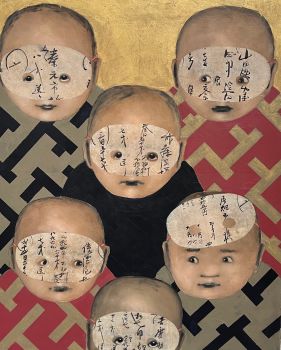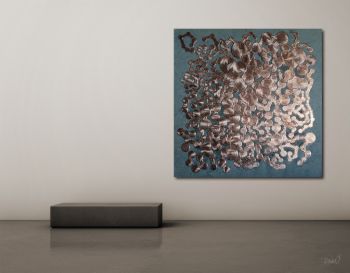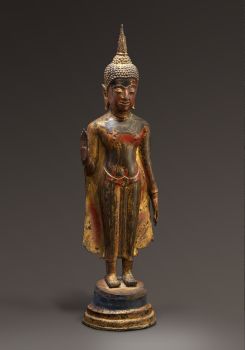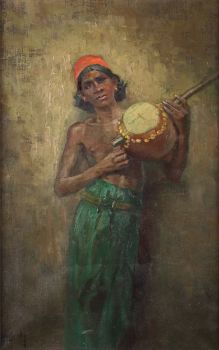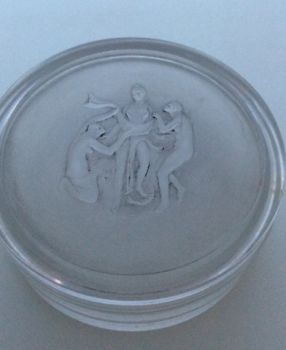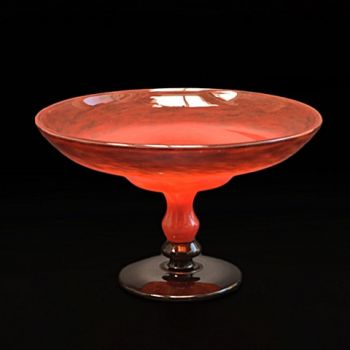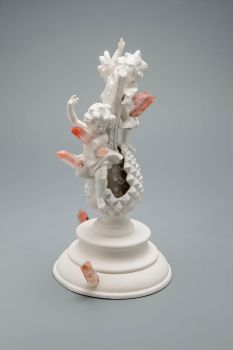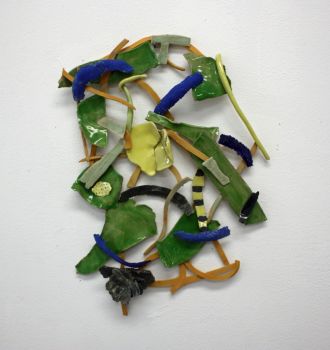Two Chinese porcelain famille rose Mancerina plates, Qianlong Qing dynasty c. 1770 Chinese export di 1770
Unbekannter Künstler
PorzellanChinesisches Porzellan
3.50 ⨯ 21.50 ⨯ 21.60 cm
ConditionGood
Preis auf Anfrage
Menken Works of Art
- Über KunstwerkA pair of two famille rose trembleuse stands or chocolate cup holders for the Spanish and Mexican market, ‘mancerina’.
China, Qianlong period, c. 1770.
The mancerina of molded scallop shell form, on raised feet with refined overglaze hand painted famille rose decorations.
These ornate, unusually large saucers with a cupholder in the centre (which are missing in this case) were special pieces made for serving chocolate. It was invented by a Spanish grandee, in Mexico, in the seventeenth century and was named after the man who had invented it, Pedro de Toledo, 1st Marquis of Mancera, who served as Viceroy of Peru from 1639 to 1648.
Called mancerina, the cup holders were designed to catch spilled liquid and help the drinker avoid burning their fingers on a hot cup. The tray could in turn be used to hold pastries. Mancerinas were first made in silver in colonial Mexico and Spain and later copied in ceramics, with models of these pieces sent to Chinese porcelain workshops.
In conclusion, these mancerina are a testament to colonial history and mutual influence between cultures connected via sea trade routes from West to East.
Dimensions (few mm varying in size):
Height 3.5 cm, width 21.5 cm, depth 21.6 cm.
Condition (DM for more pictures):
The first plate with two chips under the rim, the bottom with a star-shaped hairline in the middle (not showing on the top), the raised rim in the center on the top with a small scuff, furthermore in very good condition.
The second plate with a star-shaped hairline in the middle (also showing on the top) and a small hairline to the central border.
Identical mancerina with matching cup can be found in the following museum collections:
-Museo Nacional de Historia, Mexico City, illustrated by M. Priyadarshini, Chinese Porcelain in Colonial Mexico, p. 123, fig. 4.9.
-Carnegie Museum of Art, Pittsburgh, United States, accession no. 70.59.1
-Museum Amparo Puebla de Zaragoza, Mexico
-Museo Nacional del Virreinato, Tepotzotlán, Mexico
-Asian Civilisations Museum, 2022-00043
For a lecture in Spanish by Museo Amparo about this specific mancerina, click on the following link:
https://www.youtube.com/watch?app=desktop&v=T2exETvFg00
Also see:
https://www.youtube.com/watch?v=kJUmINIE1VQ
Inv. No: MW8 - Über Künstler
Es kann vorkommen, dass ein Künstler oder Hersteller unbekannt ist.
Bei einigen Werken ist nicht zu bestimmen, von wem sie hergestellt wurden, oder sie wurden von (einer Gruppe von) Handwerkern hergestellt. Beispiele sind Statuen aus der Antike, Möbel, Spiegel oder Signaturen, die nicht klar oder lesbar sind, aber auch einige Werke sind überhaupt nicht signiert.
Außerdem finden Sie folgende Beschreibung:
•"Zugeschrieben …." Ihrer Meinung nach wohl zumindest teilweise ein Werk des Künstlers
•„Atelier von ….“ oder „Werkstatt von“ Ihrer Meinung nach eine Arbeit, die im Atelier oder in der Werkstatt des Künstlers, möglicherweise unter seiner Aufsicht, ausgeführt wurde
•„Kreis von ….“ Ihrer Meinung nach ein Werk aus der Zeit des Künstlers, das seinen Einfluss zeigt, eng mit dem Künstler verbunden, aber nicht unbedingt sein Schüler
•"Art von …." oder „Anhänger von ….“ Ihrer Meinung nach eine Arbeit, die im Stil des Künstlers ausgeführt wurde, aber nicht unbedingt von einem Schüler; kann zeitgenössisch oder fast zeitgenössisch sein
•„Art von ….“ Ihrer Meinung nach ein Werk im Stil des Künstlers, aber späteren Datums
•"Nach …." Ihrer Meinung nach eine Kopie (jegliches Datums) eines Werks des Künstlers
• „Unterzeichnet …“, „Datiert …“. oder „Beschriftet“ Ihrer Meinung nach wurde das Werk vom Künstler signiert/datiert/beschriftet. Das Hinzufügen eines Fragezeichens weist auf einen Zweifel hin
• „Mit Unterschrift …“, „Mit Datum …“, „Mit Aufschrift ….“ oder „Trägt Unterschrift/Datum/Beschriftung“ ihrer Meinung nach die Unterschrift/Datum/Beschriftung von jemand anderem als dem Künstler hinzugefügt wurde
Sind Sie daran interessiert, dieses Kunstwerk zu kaufen?
Artwork details
Related artworks
Unbekannter Künstler
Een Gotische zuidelijke Nederlanden wandklok1580 - 1590
Preis auf AnfrageNico van den Assem restauratie
1 - 4 / 12HUGO VILFRED VON PEDERSEN
Gadesanger fra Singapore (Musician from Singapore)1870 - 1959
Preis auf AnfrageZebregs & Röell - Fine Art - Antiques
1 - 4 / 9- 1 - 4 / 24
Unbekannter Künstler
Series of 6 Chinese cups and saucers (Yongzheng period)1722 - 1735
Preis auf AnfrageKuipers Kunst & Antiek
Samuel Dejong
Anatomia Blue Heritage, Atlas Closed2017 - 2019
Preis auf AnfrageVilla del Arte Galleries
Unbekannter Künstler
Series of 6 Chinese cups and saucers (Yongzheng period)1722 - 1735
Preis auf AnfrageKuipers Kunst & Antiek
1 - 4 / 24Unbekannter Künstler
Chinese gilt bronze censer, Xuande mark, 18th century, Qing dynasty18th century
Preis auf AnfrageMenken Works of Art
1 - 4 / 5



















